Panel 1
Alessandro Di Menno di Bucchianico, Raffaela Gaddi, con il contributo della rete POLLnet-SNPA e del Centro di monitoraggio aerobiologico dell'Università degli studi di Roma Tor Vergata
The indicator describes the timing of the pollination period for a specific botanical family over the course of the year. The start and end dates, as well as the duration of the pollen season for a given family, vary by location due to the high sensitivity of pollination to local meteorological and climatic conditions. It is important to note that the duration of the pollen season is not directly correlated with the total amount of airborne pollen. A comparative analysis of the start and end dates of the monitored families' pollination can reveal the presence of airborne pollen, in certain locations, even during the months of January and December.
The start and end dates of the pollination period (calculated according to Jäger’s method), its duration, the peak concentration day, and the Annual Pollen Integral (see the “Allergenic and Annual Pollen Integral” indicator) constitute the key information describing the pollen season. This indicator is computed for each of the seven most allergenic botanical taxa widely present across the national territory: Asteraceae (also referred to as Compositae), Betuloideae and Coryloideae (subfamilies of Betulaceae, encompassing taxa formerly classified under the Betulaceae and Corylaceae families), Cupressaceae and Taxaceae (considered jointly), Oleaceae, Poaceae (also known as Gramineae), and Urticaceae.
Describe the presence in the atmosphere and the spatial and temporal patterns of allergenic pollen potentially hazardous to human health.
Directive 92/43/EEC: Council Directive on the conservation of natural and semi-natural habitats and of wild fauna and flora.
UNI 11108 – 2004: Air quality – Method for sampling and counting airborne pollen grains and fungal spores.
UNI CEN/TS 16868 – 2015: Ambient air – Sampling and analysis of airborne pollen and fungal spores for allergy networks – Hirst-type volumetric method.
UNI EN 16868 – 2019: Ambient air – Sampling and analysis of airborne pollen and fungal spores for allergy networks – Hirst-type volumetric method.
There is no specific regulation that sets concentration limits or targets for airborne pollen.
Panel 2
Jäger S., Nilsson S., Berggren B., Pessi A.M., Helander M. e Ramfjord H., 1996. Trends of some airborne tree pollen in the Nordic countries and Austria, 1980-1993. A comparison between Stockholm, Trondheim, Turku and Vienna. Grana, 35: 171-178.
Di Menno di Bucchianico, A., Gaddi, R.,Brighetti, M.A. et al. A. Status and Trend of the Main Allergenic Pollen Grains and Alternaria Spores in the City of Rome (2003–2019), Sustainability 2023, 15, 6150. https://doi.org/10.3390/su15076150.
It describes the pollination characteristics of each individual botanical family but does not account for the phenomenon as a whole.
The spatial and temporal coverage of the indicator is limited.
Activation of new monitoring stations to ensure at least one in each provincial capital.
Extension of historical data series to investigate potential relationships between the values of this indicator and certain parameters (temperature, relative humidity, CO₂) associated with climate and climate change.
Data quality assessment
SNPA (Sistema Nazionale per la protezione dell’ambiente)
Università di Roma "Tor Vergata"
The data provided by the SNPA POLLnet network are directly accessible. https://pollnet.isprambiente.it/
The data for Rome are provided by the University of Rome “Tor Vergata”. https://web.uniroma2.it/
Municipal (63/7,904)
2023
Indicator assessment
The pollen season for a given botanical family begins on the first day when at least 1% of the annual total pollen count for that family is recorded. However, this date is only valid if it is not followed by more than six consecutive days without any pollen of that species; otherwise, the next qualifying event is considered.
The season ends once 95% of the total annual pollen count for that family has been reached (Jäger et al., 1996).
In addition to these parameters, the date and value of the peak pollen concentration (i.e., the maximum daily number of grains per cubic metre recorded during the year) are also included.
The duration of the pollen season for Asteraceae, Betuloideae, Oleaceae, Poaceae, and Urticaceae is calculated on a calendar-year basis. For Coryloideae and Cupressaceae–Taxaceae, the pollen season is defined from 1 November 2022 to 31 October 2023, in accordance with the phenological dynamics specific to these two families.
In 2023, 64 monitoring stations were active (62 of which belong to the SNPA POLLnet network); for 58 of these stations, data series with sufficient data coverage (DC > 70%) were available for indicator computation. The territorial distribution covers 19 out of 20 regions. As highlighted by the graphs (Figures 1 to 7), a pronounced spatial variability of the indicator’s constituent parameters was confirmed once again this year.
The pollen season is influenced by meteorological conditions—particularly temperature and precipitation—recorded during the year at each monitored location. This results in sometimes pronounced variability both among different stations and within the same station from year to year. However, long-term observation periods spanning many more years than currently available are required to reliably identify trends.
Data
Tabella 1: Stagione pollinica Asteraceae (Compositae) (2023)
Elaborazione ISPRA su dati SNPA e Università Roma "Tor Vergata"
[1] Dati del Centro di monitoraggio aerobiologico e ambientale dell'Università di Roma "Tor Vergata"
[2] Copertura dati insufficiente
[3] In grassetto i valori che si riferiscono alle serie con almeno il 70% di dati validi
Tabella 2: Stagione pollinica Betuloideae (2023)
Elaborazione ISPRA su dati SNPA e Università Roma "Tor Vergata"
[1] Dati del Centro di monitoraggio aerobiologico e ambientale dell'Università di Roma "Tor Vergata"
[2] Copertura dati insufficiente
[3] In grassetto i valori che si riferiscono alle serie con almeno il 70% di dati validi
Tabella 3: Stagione pollinica Coryloideae (2023)
Elaborazione ISPRA su dati SNPA e Università Roma "Tor Vergata"
[1] Dati del Centro di monitoraggio aerobiologico e ambientale dell'Università di Roma "Tor Vergata"
[2] Copertura dati insufficiente
[3] In grassetto i valori che si riferiscono alle serie con almeno il 70% di dati validi
Tabella 4: Stagione pollinica Cupressacea-Taxaceae (2023)
Elaborazione ISPRA su dati SNPA e Università Roma "Tor Vergata"
[1] Dati del Centro di monitoraggio aerobiologico e ambientale dell'Università di Roma "Tor Vergata"
[2] Copertura dati insufficiente
[3] In grassetto i valori che si riferiscono alle serie con almeno il 70% di dati validi
Tabella 5: Stagione pollinica Oleaceae (2023)
Elaborazione ISPRA su dati SNPA e Università Roma "Tor Vergata"
[1] Dati del Centro di monitoraggio aerobiologico e ambientale dell'Università di Roma "Tor Vergata"
[2] Copertura dati insufficiente
[3] In grassetto i valori che si riferiscono alle serie con almeno il 70% di dati validi
Tabella 6: Stagione pollinica Poaceae (Gramineae) (2023)
Elaborazione ISPRA su dati SNPA e Università Roma "Tor Vergata"
[1] Dati del Centro di monitoraggio aerobiologico e ambientale dell'Università di Roma "Tor Vergata"
[2] Copertura dati insufficiente
[3] In grassetto i valori che si riferiscono alle serie con almeno il 70% di dati validi
Tabella 7: Stagione pollinica Urticaceae (2023)
Elaborazione ISPRA su dati SNPA e Università Roma "Tor Vergata"
[1] Dati del Centro di monitoraggio aerobiologico e ambientale dell'Università di Roma "Tor Vergata"
[2] Copertura dati insufficiente
[3] In grassetto i valori che si riferiscono alle serie con almeno il 70% di dati validi
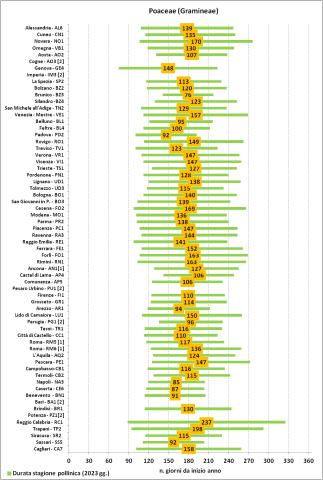
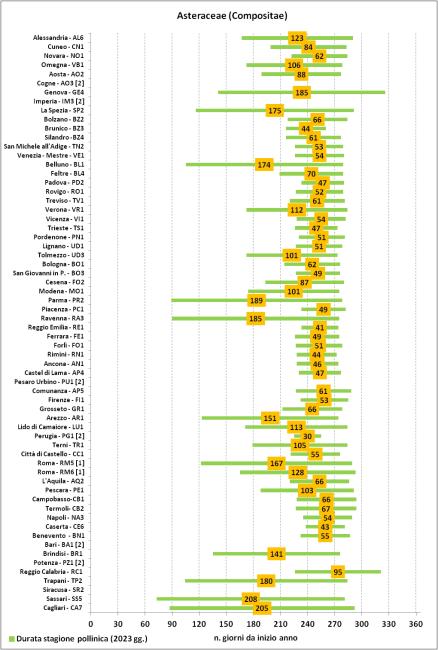
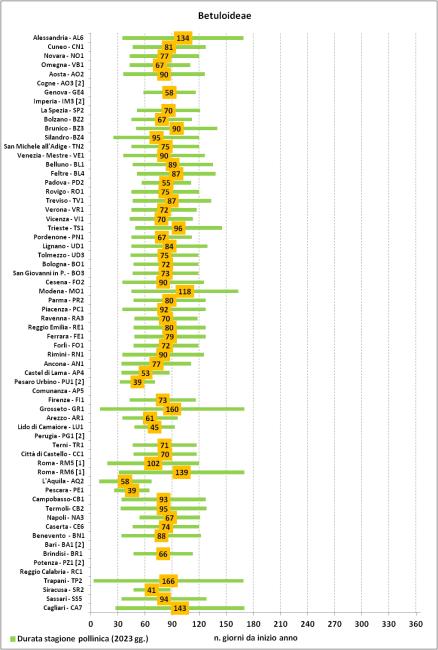
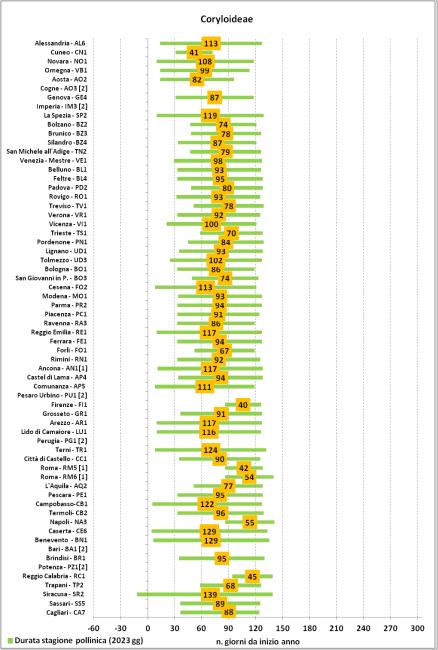
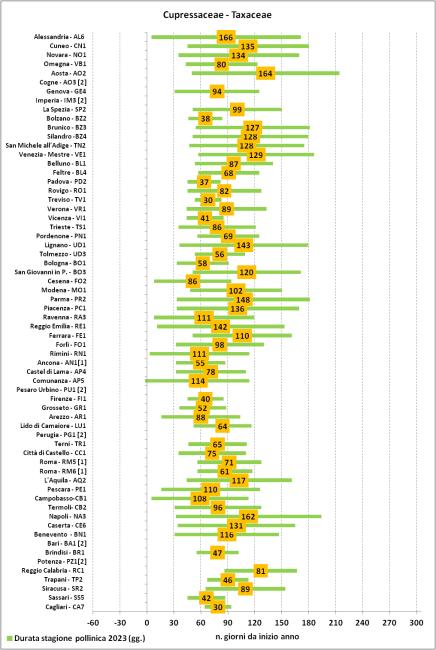
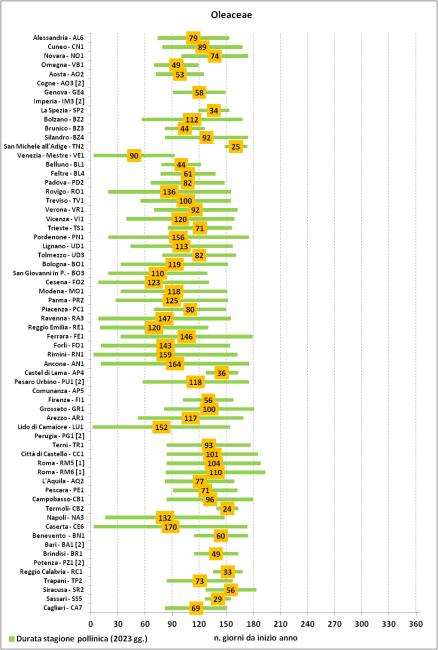
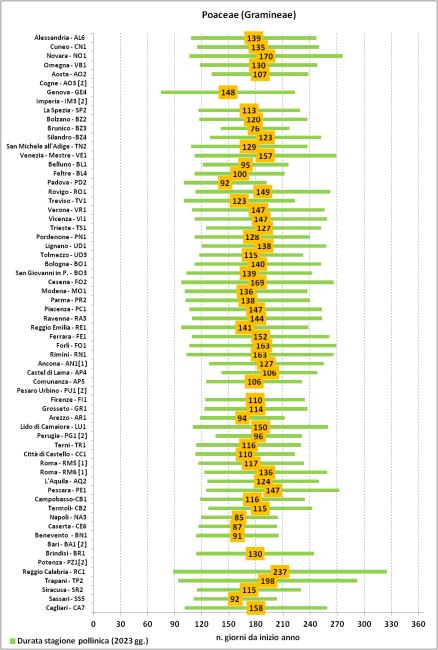
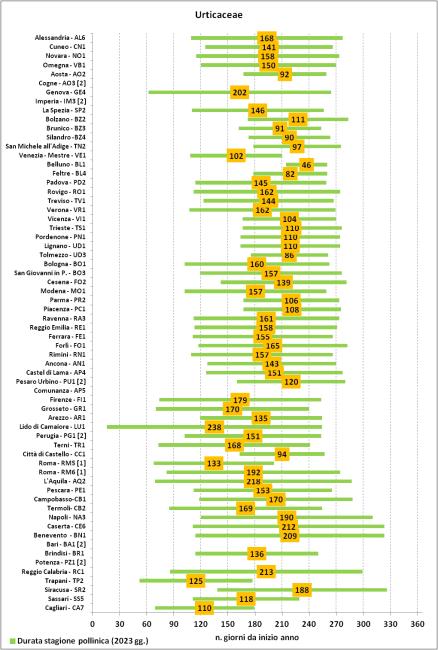
Specifically, for the various botanical families in 2023, the average duration of the pollen season was as follows:
It should be noted that the length of the pollen season is independent of the quantity of pollen emitted. To provide a quantitative understanding of the phenomenon, reference must also be made to the Annual Pollen Integral values (see the “Allergenic and Annual Pollen Integral” indicator).
Proper scheduling of mowing and pruning interventions in urban green spaces should take into account the onset of the pollen season to effectively reduce, as much as possible, the presence of allergenic pollen in the city air. Moreover, since these activities concern air quality in relation to human health, they contribute to achieving Objective 3a of the 7th Environmental Action Programme (7th EAP).